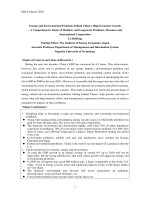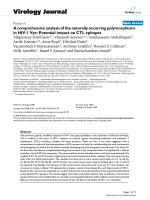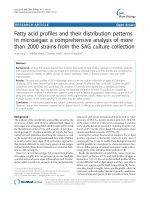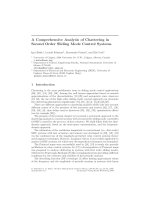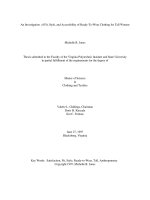A comprehensive analysis of ready to eat snack food
Bạn đang xem bản rút gọn của tài liệu. Xem và tải ngay bản đầy đủ của tài liệu tại đây (192.8 KB, 6 trang )
Int.J.Curr.Microbiol.App.Sci (2018) 7(8): 4125-4130
International Journal of Current Microbiology and Applied Sciences
ISSN: 2319-7706 Volume 7 Number 08 (2018)
Journal homepage:
Original Research Article
/>
A Comprehensive Analysis of Ready to Eat Snack Food
Reeta Mishra*, Y.D. Mishra, B.P.S. Raghubanshi and P.P. Singh
RVSKVV- Krishi Vigyan Kendra, Morena (M.P.), India
Directorate of Extension Services, RVSKVV-Gwalior (M.P.), India
*Corresponding author
ABSTRACT
Keywords
Soybean, Pearl millet,
Ready to eat snack food,
Fortification, Sensory
characteristics
Article Info
Accepted:
22 June 2018
Available Online:
10 August 2018
Ready to eat snack food (sattu) was enriched with soy and pearlmillet flour. Sattu were
evaluated for nutrient and sensory characteristics. In nutrient estimation of sattu, moisture
content was found maximum in treatment C, while protein, fat, ash, calorie content and
iron content was maximum in treatment D. The carbohydrate was found maximum in
treatment C and calcium content was maximum in treatment E. Best treatment was D
among C, D and E. The soy and pearlmillet flours fortified sattu had good shelf life. The
product is ready -to-eat so don't require much time for preparation. It is a compact source
of energy and nutrients including protein, fat, iron, calcium etc. Organoleptic test of sattus
showed that with regard to flavour and taste, body and texture, colour and appearance and
overall acceptability, sensory characteristics of D were found to be the best. The other
treatments C and E were also found acceptable. Sensory scores indicated high acceptability
for fortified ready to eat snack food sattu samples. Protein and fat contents of sattu
increased with increasing soy and pearl-millet fortifications. The implication of these
results will be realized in designing protein- energy enriched products based on pearl
millet and soy flours, especially for pearl-millet and soybean growing regions in the
Morena district of Madhya Pradesh.
into consideration (Singh and Raghuvanshi,
2012).
Introduction
Food based approaches aim at improving
nutrition by increasing the availability and
consumption of a nutritionally adequate and
micronutrient rich diet made up from a variety
of available foods. Food based approaches are
recognized as an essential part of an urgently
needed more comprehensive strategy to
combat iron and other micronutrient
deficiencies. Therefore, for solving the
problem of deep-rooted food insecurity and
malnutrition, dietary quality should be taken
Millets are considered as crop of food security
because of their sustainability in adverse agroclimatic conditions (Ushakumari et al., 2004).
These crops have substantive potential in
broadening the genetic diversity in the food
basket and ensuring improved food and
nutrition security (Mal et al., 2010).
Absence of appropriate primary processing
technologies to prepare ready-to-use or readyto-cook (RTC) products and also secondary as
4125
Int.J.Curr.Microbiol.App.Sci (2018) 7(8): 4125-4130
well as tertiary processing to prepare ready-toeat value added products have been the major
limiting factors for their diversified food uses
and better economic status (Malleshi, 2014).
Soybean is a unique crop with high nutritional
value, providing 40% protein and 20% edible
oil, besides minerals and vitamins. It is
playing an important role in augmenting both
the production of edible oil and protein.
Soybean meal is used as protein supplement in
human diet, cattle and poultry feed (Khanzada
et. al. 2013). In addition, compared to other
protein rich foods such as meat, fish, and eggs,
soybean is by far the cheapest. The importance
of soybeans and their products is primarily
associated with their high nutritional quality
especially with respect to protein and amino
acids (Gandhi, 2009).
Pearlmillet and soybean are the major crops
grown in Morena district of Madhya Pradesh.
But the main use of above crops is only as
feed and fodder in rural households.
Pearlmillet has low protein c����������������������������������������������������������������������������������������������������������������������������������������������������������������������������������������������������������������������������������������������������������������������������������������������������������������������������������������������������������������������������������������������������������������������������������������������������������������������������������������������������������������������������������������������������������������������������������������������������������������������������������������������������������������������������������������������������������������������������������������������������������������������������������������������������������������������������������������������������������������������������������������������������������������������������������������������������������������������������������������������������������������������������������������������������������������������������������������������������������������������������������������������������������������������������������������������������������������������������������������������������������������������������������������������������������������������������������������������������������������������������������������������������������������������������������������������������������������������������������������������������������������������������������������������������������������������������������������������������������������������������������������������������������������������������������������������������������������������������������������������������������������������������������������������������������������������������������������������������������������������������������������������������������������������������������������������������������������������������������������������������������������������������������������������������������������������������������������������������������������������������������������������������������������������������������������������������������������������������������������������������������������������������������������������������������������������������������������������������������������������������������������������������������������������������������������������������������������������������������������������������������������������������������������������������������������������������������������������������������������������������������������������������������������������������������������������������������������������������������������������������������������������������������������������������������������������������������������������������������������������������������������������������������������������������������������������������������������������������������������������������������������������������������������������������������������������������������������������������������������������������������������������������������������������������������������������������������������������������������������������������������������������������������������������������������������������������������������������������������������������������������������������������������������������������������������������������������������������������������������������������������������������������������������������������������������������������������������������������������������������������������������������������������������������������������������������������������������������������������������������������������������������������������������������������������������������������������������������������������������������������������������������������������������������������������������������������������������������������������������������������������������������������������������������������������������������������������������������������������������������������������������������������������������������������������������������������������������������������������������������������������������ontent was observed in different types
of sattu mixes. Crude fiber content ranged
from 3.34 to 3.61 percent. Significantly higher
fiber content was observed in type E. Energy
values for product C, D and E were 364.4,
370.95 and 367.3 kcal/100g, respectively.
The mineral content of sattu for iron and
Calcium of different types of sattu ready
mixes varied significantly with each other.
Highest calcium content was observed in type
E, followed by type D and C, respectively.
Higher calcium content observed in D and E
might be due to incorporation of pearlmillet.
Further, as the soy fortification increased,
reduction in carbohydrate was observed. This
might have happened since the soybean
contains low carbohydrates. Increase in total
minerals may be attributed to higher amount
of minerals present in the soybean and
pearlmillet.
Deshpande et al., (2004) have reported similar
results for fortified foods developed for
adoption at home and community level.
Sensory evaluation of fortified sattu
Nine-point hedonic scale was used to evaluate
the acceptability of the products. The results
of the nine-point hedonic scale for C, D and E
products of sattu were presented in Table 3.
Colour
The mean sensory scores showed that there
was a major difference among treatments C, D
and E (Table 2). The scores for colour ranged
from 6.54 to 7.52. The highest was recorded
for treatment D followed by C and E.
However colour scores increased slightly as
the substitutes increased (Ugwuona, 2009).
4127
Int.J.Curr.Microbiol.App.Sci (2018) 7(8): 4125-4130
Fig.1 Flow –chart for preparation of ready to eat snack food (sattu)
Cleaning (Soybean, wheat/pearlmillet and Bengal gram)
↓
Conditioning to 30% moisture (Each ingredient separately)
↓
Roasting (Each ingredient separately)
↓
Dehulling/ dehusking (Each ingredient separately)
↓
Mixing of ingredients in selected proportions
↓
Grinding of mix
↓
Sifting (ISS 30)
↓
Packaging in packaging material
Table.1 Nutritional composition of fortified sattu
Parameter
% Moisture
% Crude fibre
%Ash
% Crude fat
% Crude protein
% Carbohydrate
Energy (Kcal/100g)
Iron (mg/100g)
Calcium (mg/100g)
C
10.23
3.34
2.86
5.96
18.65
58.96
364.4
5.3
173.6
D
9.94
3.47
3.14
7.39
20.19
55.9
370.95
5.98
183.7
E
9.89
3.61
3.09
6.69
19.16
57.56
367.3
5.52
189.8
*Significant difference
Table.2 Composite rating of fortified sattu
Parameter
C
D
E
F-value
Color
Taste
Flavour
Texture
Overall
acceptability
7.00
7.12
6.92
7.12
7.24
7.52
7.64
7.44
7.60
7.92
6.54
6.60
6.60
6.80
6.62
24.04
19.314
12.836
15.012
33.03
4128
Significant(S)/ CD at 5%
Nonlevel
significant
(NS)
S
0.436
S
0.516
S
0.516
S
0.453
S
0.484
Int.J.Curr.Microbiol.App.Sci (2018) 7(8): 4125-4130
Table.3 Rating of ready to eat snack product (sattu) moderately for preference by hedonic scale
Products
Mean score
C
D
E
7.34
7.92
6.40
Preference
F-value
Significant(S)/ Nonsignificant (NS)
CD at 5%
level
50.09
S
0.472
Like moderately
Like moderately
Like slightly
* Nine-point hedonic scale was used to evaluate consumer’s acceptability of products
different products prepared as soy-blended
snacks at domestic level.
Taste
Major differences were observed among three
types of prepared sattu. The highest sensory
score was recorded for sample D (7.64)
followed by sample C (7.12). The least was
recorded for treatment E (6.60).
Flavour
All three sattu exhibited significant difference
in regards to flavour component. The highest
score was recorded for treatment D.
Texture
The mean texture scores ranged from 6.80 to
7.12. A major difference was observed among
three. The highest score (7.60) was recorded
for treatment D.
Overall acceptability
The highest sensory score (7.92) was recorded
for treatment D followed by treatment C.
It shows that product D had highest scores,
followed by product C and product E. The
difference among all the products was found
to be significant (P<0.05).
These products were devoid of off flavour and
possessed acceptable characteristics. The
results are in accordance with Deshpande
(1990) and Deshpande and Joshi (2001) who
reported similar results while evaluating
Storage and shelf life of sattu
Packaging of prepared products is necessary
to prevent contamination during transport and
storage. Prepared sattu could be stored safely
for 60 days in humid and warm conditions of
storage in metal containers while the LDPE
packages stored it safely for 30 days in warm
conditions and 15 days in humid conditions.
Soybean and pearl-millet flour have high
nutritive value. Sattu prepared from
incorporation of soybean and pearl-millet was
acceptable at incorporation level of 15%.
Thus, soybean-pearlmillet ready to eat snack
food may be helpful to increase intake of
protein, fat and calories by improving the
dietary intake of farm women and their family
members. Hence, blend of soybean and
pearlmillet incorporation has potential as an
ingredient in healthy low cost nutritious ready
to eat foods.
To improve the nutritional quality of cerealbased traditional diets in Morena district of
Madhya Pradesh, the use of soybean as a
protein supplement has often been suggested.
Supplementation of pearl millet with soybean
makes it nutritionally superior and produces
acceptable food products for enhancement of
nutritional status of farm women and their
family members.
4129
Int.J.Curr.Microbiol.App.Sci (2018) 7(8): 4125-4130
References
Deshpande, S.D. (1990). Studies on some
engineering aspects for processing and
utilization of soybean. Ph.D. Thesis,
Indian
Institute
of
Technology,
Kharagpur.
Deshpande, S.S. and Joshi, K.C. (2001). Soy
sattu- paushtik evam swadishta bhojya
padarth. Kheti Sansar, 6: 15.
Deshpande, S.S., Joshi, K.C., Bargale, P.C.,
Jha, K., Singh, V. and Varghese, S.
(2004). Development, acceptability and
shelf life studies on soy fortified maize
sattu. Journal of Food Science &
Technology, 41(6): 674-678.
Gandhi, A.P. (2009). Quality of soybean and
its food products. Central Institute of
Agricultural
Engineering, Bhopal462038(MP), India. International Food
Research Journal, 16: 11-19.
Gopalan, C., Ramasastry, B. and Manian,
S.C. (2000). Nutritive value of Indian
foods, National Institute of Nutrition,
Indian Council of Medical Research,
Hyderabad, India.
Khanzada, S.R., Khanzada, M.S., Abro, G.H.,
Syed, T.S., Soomro, K., Khanzada, A.
M., Anwar, S. and Shakeel, N. (2013).
Relative resistance of soyabean
cultivars against sucking insect pests.
Pakistan Journal of Science, 65(2): 97201.
Mal, B., Padulosi, S. and Ravi, S.B. (2010).
Minor millets in South Asia: Learnings
from IFAD-NUS Project in India and
Nepal. Maccarese, Rome, Italy:
Bioversity Intl., and Chennai, India:
M.S.
Swaminathan
Research
Foundation: pp.1-185.
Malleshi,
N.G.
(2014).
Post-harvest
processing of millets for value addition.
/fs/docs/icb.topic868074., cited on
21.07.2014.
Rawat, A., Singh, G., Mittal, B.K. and Mittal,
S.K. (1994). Effect of soy fortification
on quality characteristics of chapaties. J
Food Sci. Technol., 31: 114 – 116.
Singh, G., Sehgal, S. and Kwatra, A. (2006).
Sensory and nutritional evaluation of
cake developed from blanched and
malted pearl millet. J Food Sci Technol.
43 (5): 505 – 508.
Singh, P. and Raghuvanshi, R.S. (2012).
Finger millet for food and nutritional
security. African Journal of Food
Science, 6: 77-84.
Ugwuona, F.U. (2009). Chemical and sensory
evaluation of soy-fortified cassava
wheat biscuit. Journal of Tropical
Agriculture, Food, Environment and
Extension, 8 (1): 55-59.
Ushakumari, S.R., Shrikantan, L. and
Malleshi, N.G. (2004).The functional
properties of popped, flaked, extruded
and roller dried foxtail millet (Setaria
italica). International Journal of Food
Science and Technology, 39: 907-915.
How to cite this article:
Reeta Mishra, Y.D. Mishra, B.P.S. Raghubanshi and Singh, P.P. 2018. A Comprehensive
Analysis of Ready to Eat Snack Food. Int.J.Curr.Microbiol.App.Sci. 7(08): 4125-4130.
doi: />
4130




